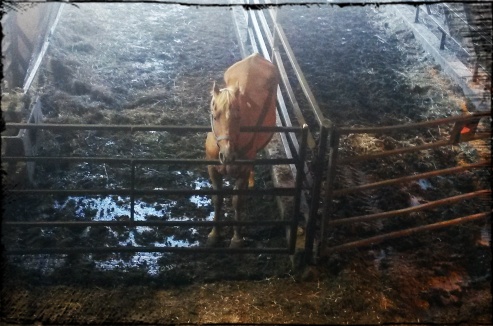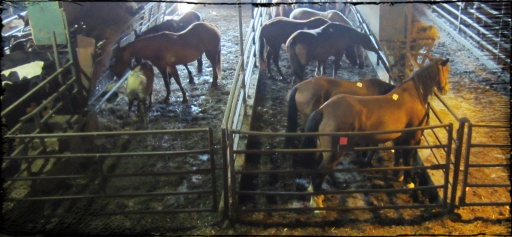Written by: Brian
I’m not sure which horse is haunting me the most. There was Jack. Big part draft gelding, 23 years old. Skinny as skinny, with large white saddle sore scars. Someone used him hard and threw him away.
Ginger was 26, from the same place as Jack. Friendly and gentle. She came to the fence to say hello.
The Percheron filly was a black beauty. After her trip to Alberta she might be one of the chosen ones to be shipped live from the Calgary airport. If she survives the trip (sometimes all the horses arrive dead), she’ll be slaughtered in Japan and served up raw as a high priced delicacy.
Twenty year old Copper won’t be as tender. He had some hard miles on him.
The dunn mare was in her prime, eleven years old, trained to pull a cart. She came into the sale ring with a rider on her back for the very first time, and handled it like a pro. It wasn’t enough.
The sturdy paint horses and the chunky six year old sorrel were typical slaughter horses, with their whole lives ahead of them. Not any more.
Usually it’s the young ones the kill buyers go for, not the old and feeble, despite what the industry tells you about horse slaughter being a “humane end of life option.” The kill buyers didn’t get as many as usual, but this auction was especially brutal, because most of the ones they did get were older.

A thin horse stands alone in the kill pen at OLEX in St. Jacob’s Ontario – even the sweltering July heat cannot dry out the permanent muck
Bucky was the most memorable. His hip bones jutted out from his emaciated body, and a swollen wound on his cannon bone was heading towards proud flesh. He’d spent his 25 years teaching children to ride. But why put him down humanely when you can make a few bucks?
Bucky nickered softly to us as we left the yard after the sale. He was probably hoping we’d give him some hay and water after hours of going without. He’d have to wait for that.
The meat horses would be shunted into a pen together, and Bucky would take a few kicks before being chased from his scrap of hay. If anyone bothered to feed them. Regulations say horses can go 36 hours without food or water.
Who knows how many doses of bute Bucky had in his long life. Like all the horses, he was dropped off with no questions asked. One dose of bute carries a lifetime ban for human consumption.
But Bucky ain’t never had no bute! Even though that festering wound was fresh and he was a jumping horse, Bucky never had no drugs! No wormers, no pain killers, no bute…
He arrived at Bouvry with a fresh, clean EID, filled out by the kill buyer stating that “to the best of my knowledge” Bucky was drug free. Him and all them others that came with no medical information. Hell! They ain’t never had nothin!

Failed ostrich farmer Gerry Ritz, Minister of Agriculture – bureaucratic idiot and exasperating obfuscator. Activists exist largely because our civil servants, who are responsible for safeguarding animals and supervising the inputs into the food chain, do so in a questionable or disrespectful manner towards their own citizens and those of countries to whom we export foodstuffs.
That’s the CFIA’s story and they’re sticking to it. Once at the slaughterhouse the EIDs become the plant’s property and go into cold storage where even a Freedom of Information Request can’t get them out.
I’ve been thinking about Bucky and the others all week. And I still remember Sky from 11 years ago. Pretty young Arab. She was a playful thing, jousting with her pasture mate in the stock pen. After the sale her lifetime friend was led away by a new owner, and Sky was left standing alone in the cold rain, confused. They always know when something’s not right.
The two sleek four year old geldings hid their heads in the corner. The bidding didn’t last long for them. Next.
A teenage girl came in proudly leading her childhood love, and left with a stunned look on her face when he sold for $100. She probably preferred boys now and her parents said, “That horse has to go!”
The sick mare with firehose diarrhea could barely walk. She’d be a downer for sure, but even trampled to death she’d be worth a case of beer.
Of course I’ll never forget the load of full term pregnant wild mares being prodded onto a double decker with 50 other horses, falling and thrashing and banging. The noise was something else! The CFIA sure wanted to shut me up about that illegal shipment.
The auction claims there are no kill buyers at their sales. Only “horse brokers,” who train them ponies up for resale. Ask for yourself. The guy who sits up in the corner with a calculator will tell you where they’re going. “To a friend in Alberta.”
Arriving at Bouvry with their squeaky clean EIDs, the horses were probably unloaded right into the kill line. So much for the six month holding period required by law. They don’t even pretend to follow the rules. I sure wish the EU was paying attention.
I wonder if Bucky’s had his turn yet? I imagine him smelling the fear as he’s driven closer to the stun box, his ears flickering back and forth, the smell of blood overpowering and the noise

Here is Bucky. It’s important to acknowledge that the Horse Welfare Alliance of Canada’s formation began in response to Canada’s anti-slaughter movement, prompted by the CHDC’s first investigative report, “Black Beauty Betrayed” in 2008. The true purpose of HWAC, headed by Bill DesBarres, is not horse welfare, but the promotion and support of North America’s horse slaughter industry.
deafening. Saws whining and a radio blaring. The humans Bucky grew up trusting shouting and laughing, prodding him with a white stick that sends a jolt through his old bones as he stumbles forward into a blood soaked metal cage, looking frantically for a way out.
He’s a big horse. Maybe the first few shots glanced off his high head, taking out an eye or hitting him in the ear as the shooter casually took his time reloading his gun. I wonder if Bucky has figured out yet that humans are no longer his friend?
Horse “welfare” advocate, Bill DesBarres (HWAC), claims that without slaughter Canada would be overrun with unwanted horses. But almost 70% come from the US. They trickle into the system, one by one, like Bucky and Jack, from owners who are not desperate but just want an easy way out. (By the way, Bill and Claude Bouvry go way back.)
The biggest misconception of all is that banning horse slaughter in the US caused a surge of neglect. The crashed economy, drought and skyrocketed hay prices caused the neglect, not the slaughter ban. The number of horses slaughtered never changed. Owners could ditch them at an auction same as always.
You won’t hear that from Equine Canada. They’ve latched onto the neglect myth and people believe it. They pushed it hard on MPs too, trying to get them to vote against Bill C-571.

The horses are healthy, as are over 90% of all slaughter-bound horses, contrary to statements made by Equine Canada
The horses are healthy, as are over 90% of all slaughter-bound horses, contrary to statements made by Equine Canada
If people would quit breeding so many the numbers would drop pretty quick. Even the responsible breeders don’t break even, driven out of business by everyone who has a mare thinking she should be bred.
All those beautiful babies, in every colour of the rainbow, selling for as little as $100. The breeder brought them from Alberta, knowing that if he sold them there they’d all go for meat. But how many years before they end up back at the auction?
Yesterday a slaughter bound semi carrying 27 horses crashed in Saskatchewan, killing the driver of an SUV and 12 of the horses. How many Jacks and Buckys were on that load?
The CFIA chased reporters away and won’t divulge what happened to the surviving horses. But there are rumors of a Clyde and a pony being reloaded onto a fresh slaughter truck. No matter their terror and broken bones. The production line was waiting.
The ones that died in the crash were the lucky ones. At least their death was kinder than the one they were headed for at Bouvry.
Back at the riding school there’s probably a new horse. The children will stroke him and feed him carrots, and never forget him. Like I’ll never forget Bucky.
Why do I torture myself by going? Because knowledge is power, and maybe when enough people find out the truth about horse slaughter, they’ll care. I hope someone who once knew Bucky sees this post. Or someone in the EU.
Please share.














